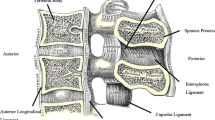Summary
A general nonlinear theory of a mixture of interacting directed curves is developed. Constitutive equations are presented for a class of viscoelastic materials with fading memory. A model of the ligamentous spine as a composite or mixture of directed curves is proposed. Suitable constraints are imposed which yield a simple nonlinear theory governing the response of the spine regarded as a composite rod which can undergo bending, twisting, axial extension and cross-sectional shear deformation.
Zusammenfassung
Die Arbeit befaßt sich mit der Entwicklung einer allgemeinen Theorie für eine Mischung von richtungsorientierten Kurven. Stoffgleichungen für einen einfachen viskoelastischen Werkstoff mit verschwindendem Gedächtnis werden hergeleitet. Um die Anwendung der allgemeinen Theorie zu beweisen, wird eine Mischung spezieller orientierter Kurven als ein mathematisches Modell der Wirbelsäule vorgeschlagen. Sodann wird auf Grund einer einfachen nichtlinearen Theorie gezeigt, daß es genügt, das mechanische Verhalten der Wirbelsäule durch ein aus zwei Komponenten zusammengesetzten Stab, mit Längs- und Schubdehnung, Biegungs- und Verdrehungsdeformation, darzustellen.
Similar content being viewed by others
References
Antman, S.: The Theory of Rods. Handbuch der Physik, Vol. VIa/2. Berlin-Heidelberg-New York: Springer. 1972.
Cohen, H.: A Nonlinear Theory of Elastic Directed Curves. Int. J. of Engng. Sci.4, 511–524 (1966).
Whitman, A. B., andC. N. De Silva: A Dynamical Theory of Elastic Directed Curves. ZAMP20, 200–212 (1969).
Whitman, A. B., andC. N. DeSilva: Dynamics and Stability of Elastic Cosserat Curves. Int. J. Solids Structures6, 411–422 (1970).
Whitman, A. B., andC. N. DeSilva: Stability in a Linear Theory of Elastic Rods. Acta Mechanica15, 295–308 (1972).
DeSilva, C. N., andA. B. Whitman: A Thermodynamical Theory of Directed Curves. J. Math. Phys.12, 1603–1609 (1971).
Craine, R. E., A. E. Green, andP. M. Naghdi: A Mixture of Viscous Elastic Materials with Different Constituent Temperatures. Quart. J. Mech. Appl. Math.23, 171–184 (1969).
DeSilva, C. N. andP. Kaloni: The Balance Equations of Reacting Oriented Continua. J. de Mechanique8, 543–548 (1969).
Green, A. E., andP. M. Naghdi: A Theory of Mixtures. Arch. Rat. Mech. Anal.24, 243–263 (1967).
Green, A. E., andP. M. Naghdi: On Basic Equations for Mixtures. Quart. J. Mech. Appl. Math.22, 427–438 (1969).
Green, A. E., andP. M. Naghdi: The Flow of Fluid Through an Elastic Solid. Acta Mechanica9, 329–340 (1970).
Green, A. E., andP. M. Naghdi: Entropy Inequalities for Mixtures. Quart. J. Mech. Appl. Math.24, 473–485 (1971).
Green, A. E., andN. Laws: Global Properties of Mixtures. Arch. Ratl. Mech. Anal.43, 45–61 (1971).
DeSilva, C. N., andM. Sioshansi: Mixure Theory of Directed Surfaces and a Model of the Cornea. Acta Mechanica19, 89–108 (1974).
Coleman, B. D., andW. Noll: An Approximation Theorem for Functionals with Application to Continuum Mechanics. Arch. Ratl. Mech. Anal.6, 355–370 (1960).
Coleman, B. D.: Thermodynamics of Materials with Memory. Arch. Ratl. Mech. Anal.17, 1–46 (1964).
Rizzi, M. A.: Die menschliche Haltung—klinische und biomechanische Betrachtungen. Zeit. für Präventivmed.17, 341–348 (1973a).
Rizzi, M. A.: Untersuchungsmethoden zur Beurteilung der Haltung. Zeit. für Präventivmed. (to appear. 1973b).
Steindler, A: Kinesiology of the Human Body. Springfield, Ill.: Charles C Thomas. 1955.
Rasch, P. J., andR. K. Burke: Kinesiology and Applied Anatomy. Philadelphia: Lea and Febiger. 1971.
Chacon, R. V., andR. S. Rivlin: Representational Theorems in the Mechanics of Materials with Memory. ZAMP15, 444–459 (1964).
Roberts, V. L., E. L. Stech, andC. T. Terry: Review of Mathematical Models which Describe Human Response to Acceleration. A.S.M.E. Paper No. 66-WA/BHF-13 (1966).
Orne, D., andY. K. Liu: A Mathematical Model of Spinal Response to Impact. J. Biomechanics4, 49–71 (1971).
von Gierke, H. E.: Biodynamic Models and their Applications. J. Acoust. Soc. Am.50, 1397–1413 (1971).
Hirsch, C.: The Reaction of Intervertebral Discs to Compression Forces. J. Bone Jt. Surg.37-A, 1188–1196 (1965).
Moffat, C. A., andR. H. Howard: The Investigation of Vertebral Injury Sustained During Aircrew Ejection. Technology Inc., San Antonio, Texas. Q. Prog. Rep. No. 2, NASA Contract NAS 2-5062 (1968).
Whitman, A. B., andC. N. DeSilva: An Exact Solution in a Nonlinear Theory of Rods. J. Elasticity4 (1974).
Author information
Authors and Affiliations
Rights and permissions
About this article
Cite this article
Rizzi, M.A., Whitman, A.B. & DeSilva, C.N. A mathematical model of the spine based on mixture theory of directed curves. Acta Mechanica 21, 241–260 (1975). https://doi.org/10.1007/BF01181057
Received:
Issue Date:
DOI: https://doi.org/10.1007/BF01181057




